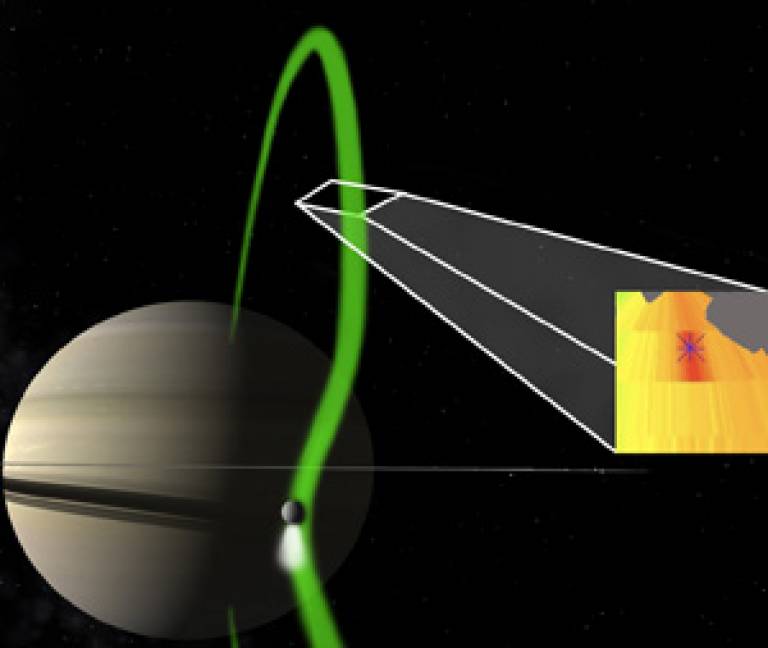Beams of electrons link Saturn with its moon Enceladus
20 April 2011
Links:
 mssl.ucl.ac.uk/" target="_self">UCL Mullard Space Science Laboratory
mssl.ucl.ac.uk/" target="_self">UCL Mullard Space Science Laboratory
Data from NASA's
Cassini spacecraft have revealed that Enceladus, one of Saturn's diminutive
moons, is linked to Saturn by powerful electrical currents - beams of electrons
that flow back and forth between the planet and moon.
The finding is part of a paper published in Nature today. CAPS, one of the instruments on board Cassini which made the electron beam discovery, includes a electron sensor called CAPS-ELS - led by UCL (University College London).
Since Cassini's arrival at Saturn in 2004 it has passed 500km-wide Enceladus 14
times, gradually discovering more of its secrets on each visit. Research
has found that jets of gas and icy grains emanate from the south pole of
Enceladus, which become electrically charged and form an ionosphere. The motion
of Enceladus and its ionosphere through the magnetic bubble that surrounds
Saturn acts like a dynamo, setting up the newly-discovered current system.
Scientists already knew that the giant planet Jupiter is linked to three of its
moons by charged current systems set up by the satellites orbiting inside its
giant magnetic bubble, the magnetosphere, and that these current systems form
glowing spots in the planet's upper atmosphere. The latest discovery at
Enceladus shows that similar processes take place at the Saturnian system too.
The detection of the beams was made by the Cassini Plasma Spectrometer's
electron spectrometer, CAPS-ELS, the design and building of which was led at
UCL's Mullard Space Science Laboratory. UCL co-authors of the Nature paper, Dr
Geraint Jones and Professor Andrew Coates, are delighted with this new finding.
Dr Jones said: "Onboard Cassini, only CAPS-ELS has the capability of directly
detecting the electron beams at the energies they're seen; this finding marks a
great leap forward in our understanding of what exactly is going on at
mysterious Enceladus."
Lead co-investigator of CAPS-ELS, Professor Coates, added: "This now looks like
a universal process - Jupiter's moon Io is the most volcanic object in the
solar system, and produces a bright spot in Jupiter's aurora. Now, we see the
same thing at Saturn - the variable and majestic water-rich Enceladus plumes,
probably driven by cryovolcanism, cause electron beams which create a
significant spot in Saturn's aurora too."
The Nature paper in which the discovery is reported is co-led by Dr Wayne Pryor
of Central Arizona College and Dr Abigail Rymer of the Johns Hopkins University
Applied Physics Laboratory. The work also reports the presence of an
ultraviolet auroral spot in Saturn's upper atmosphere, and of energetic ions
flowing towards Enceladus: discoveries made using other Cassini instruments.
Cassini-related work at UCL-MSSL is supported by the UK Space Agency, the Science and Technology Facilities Council, and the European Space Agency. Geraint Jones is supported by a STFC Advanced Fellowship.
Image: A beam of electrons linking Saturn and Enceladus. The green line provides an approximate trace of the magnetic field lines connecting Saturn's ionosphere with Enceladus and its south polar plume of gas and icy grains. The inset shows the electron beam viewed by CAPS-ELS during Cassini's encounter with Enceladus on October 31st, 2008. The centring of the electron beam on the position of the magnetic field (asterix) indicates that the electrons are flowing parallel to the local magnetic field. Credit: Geraint Jones, UCL
Media contact: Clare Ryan
UCL context
The UCL Mullard Space Science Laboratory delivers a cutting-edge science programme, underpinned by a capability in space science instrumentation, systems engineering and project management. Its staff are committed to a broad outreach programme and are very happy to receive enquiries from the public and fellow space science professionals alike.
Related news
UCL space missions get the go-ahead
 Close
Close

